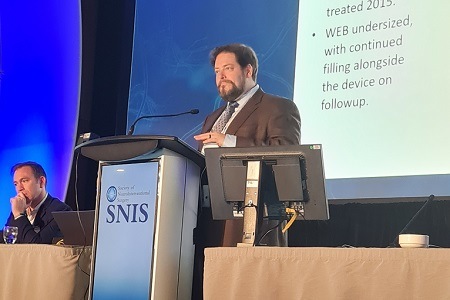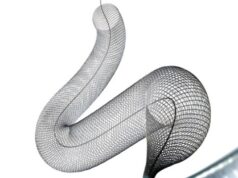
The Society of NeuroInterventional Surgery’s (SNIS) 19th annual meeting (25–29 July 2022, Toronto, Canada) saw research involving the Woven EndoBridge (WEB; Microvention/Terumo) device disclosed for the first time, with co-principal investigator Adam Arthur (University of Tennessee Health Sciences Center and Semmes-Murphey Clinic, Memphis, USA) delivering a late-breaking presentation of five-year data from the WEB-IT trial.
Arthur began by noting that the study enrolled 150 patients with wide-neck cerebral aneurysms across 26 global sites, and its primary endpoints were originally assessed at one year, but researchers did “everything they could” to follow patients out to five years. He also said follow-up in a five-year study is “difficult”, adding that “COVID-19 has affected our practice and this study a fair amount”, and noting that the pandemic was responsible for some missing imaging data.
Discussing safety findings, Arthur said: “It is really exciting to see that, in a trial of 150 patients, 148 of whom got the device, not one of the treated aneurysms has experienced a rupture—the ruptured aneurysms did not re-rupture and the unruptured aneurysms did not rupture.” Arthur also reported seven deaths and five subarachnoid haemorrhages, two of which were deemed to have been related to the device.
Moving on to detail effectiveness data, he stated: “In looking at occlusion status shifts, there are more patients with progressive occlusion than with worsening of occlusion status. And, using last observation carried forward methodology, we see a stable and high number of complete occlusions and adequate occlusions.”
Drawing comparisons between these recent findings and one-year WEB-IT data, Arthur reported an increased complete occlusion rate, from 57.9% at one year to 58.1% at five years, and a marginal decrease in terms of adequate occlusion rate, from 87.9% to 87.2%.
Arthur went on to add that, in WEB-IT’s US cohort, a retreatment rate of 15.5% (23 of 148 patients) was observed over the five years, and all retreatments were completed safely. He noted that “absolutely no aneurysm bleeds” occurred in the study, but said there were two significant, aneurysm-related adverse events following retreatment with a flow diverter—one of which involved a stroke, and one of which resulted in patient death following an angioplasty.
“Aneurysm location is interesting,” Arthur continued. “Obviously, these are point estimates, and there is not enough statistical power to really say something meaningful, but I do find it intriguing that, at the MCA [middle cerebral artery] location, there is some suggestion of a higher retreatment risk. I think a larger cohort may tell us something interesting here.”
Arthur concluded by noting that the intrasaccular segment presents a new strategy that he finds “extremely promising”. “I think the WEB device has now been shown, in a long-term cohort—which is important—to be both safe and effective,” he added. “It is fantastic that none of these patients experienced the endpoint that we most wanted to avoid, which was haemorrhage of the aneurysm.”
The speaker further claimed that, while WEB-IT saw a retreatment rate of 15.5%, retreatments of WEB are “quite easy and quite safe”, although he followed this by noting there is a need to be “careful” when it comes to subsequent interventions after the first retreatment due to the dangers they pose.













